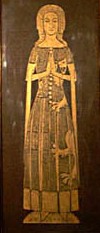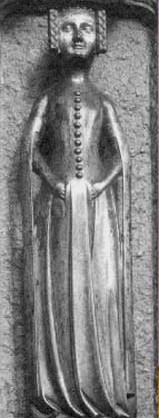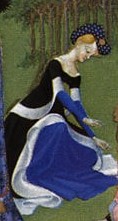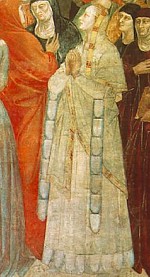
Tippets
& Lappets
The Arm Accessories of The 14th Century
From approximately 1340 until
1390, an arm ornament known as the tippett or tappit
appeared. Household accounts to date have not shown any mention
of the accessory being recorded in wills and inventories, although
it is written that they were stored between boards to keep them
perfectly flat or 'flattened' to remain crease-free.

 What
is a tippet? What
is a tippet?
Tippets are streamer-like
strips of fabric which appear to be attached to a band circling
the upper arm just above the elbow. One manuscript image indicates
the tippet may have been sewn to the actual sleeve.
some believe that the tippet was an individual item of clothing
which was detachable and tied, laced, or possibly buttoned or
was sewn closed and slipped on up the arm. I have seen no references
for buttoned, tied or laced tippets. Manuscript images at this
time are very indistinct, not showing fine details of clothing
and dress accessories.
There are records of the extended sleeve being referred to as
typites and tipets although this was when the extended sleeve
of the kirtle first became popular and the same extended streamers
on hoods were also named likewise.

 Tippets
in art. Tippets
in art.
Seen above at left is the memorial brass of Lady Maude De Foxle,
dated 1387 and at right is the tomb effigy of Joan De La Tour
dated 1377-1386. Both clearly show the band around the upper arm
above the elbow and the tippet at the side or towards the front
of the arm. Whether they are integral to the gown or seperate,
it cannot be determined.
Tippets which appear fur-lined
and part of the outer gown are shown in few artworks but tippets
which appear to be a separate item can be seen in detail on many
memorial brasses of the late 14th century.
 The
detail at left is taken from the 1412-1416 illuminated manuscript
of the Heures du duk du Berry. The April scene shows a
woman in a blue kirtle and dark overgown with short sleeves and
tippets. The
detail at left is taken from the 1412-1416 illuminated manuscript
of the Heures du duk du Berry. The April scene shows a
woman in a blue kirtle and dark overgown with short sleeves and
tippets.
It is uncertain whether the
tippets are of the same fabric or fur lining the gown or a different
fabric altogether. It is clear that the tippets are white both
front and back, but it is also unclear whether they are attached
to the overgown or not.

What
is a lappet?
Fur tippets v hanging sleeves.
The image at right is a detail
from an armorial roll and shows the wife of de Revel is a gown
with streamers which appear ermine lined hanging from her upper
arms. The wide white arm band is not shown here and it is interesting
to not the angle of the streamers dangling, which appear to come
from the elbow although the gown sleeves are much higher on the
arm. Whether this is an artistic anomaly or whether the streamers
come from the elbow is not clearly shown.
 Medieval
clothing researcher, Robin Netherton's research leads her to conclude
that they were not linen or silk as generally supposed, but fur.
It makes a deal of sense to suppose that the long streamers of
some gowns may have been slashed and sewn at the back creating
a tippet-like streamer dangling from the elbow. Medieval
clothing researcher, Robin Netherton's research leads her to conclude
that they were not linen or silk as generally supposed, but fur.
It makes a deal of sense to suppose that the long streamers of
some gowns may have been slashed and sewn at the back creating
a tippet-like streamer dangling from the elbow.
Since many gowns were fur-lined, it also follows that the resulting
streamer would be fur.
The image at left is a detail
from a fresco painted in 1350 by di Cione called The Last Judgement.
It shows long streamers which appear to be lined with fur which
matches the fur at the bottom of her gown. It appears that these
streamers are not a separate item but a part of the gown. It also
lacks the broad armband which is typical of the tippet proper.
My current thoughts are that
the idea for the tippet as an accessory would have started out
as the slashed and sewn fur sleeve and evolved into a separate
item which would have been easier to clean and bleach.
Since the tippet is almost always shown to be white, constant
laundering must be considered. Only rarely are tippets shown as
red, green or blue. As far as I have seen, this seems to be peculiar
to Italy alone.

Copyright
© Rosalie Gilbert
All text & photographs within this site are the property of
Rosalie Gilbert unless stated.
Art & artifact images remain the property of the owner.
Images and text may not be copied and used without permission.
|